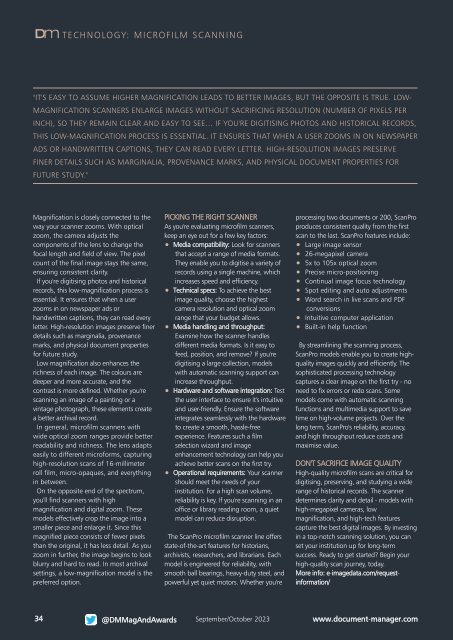You also want an ePaper? Increase the reach of your titles
YUMPU automatically turns print PDFs into web optimized ePapers that Google loves.
Dm TECHNOLOGY: MICROFILM SCANNING<br />
"IT'S EASY TO ASSUME HIGHER MAGNIFICATION LEADS TO BETTER IMAGES, BUT THE OPPOSITE IS TRUE. LOW-<br />
MAGNIFICATION SCANNERS ENLARGE IMAGES WITHOUT SACRIFICING RESOLUTION (NUMBER OF PIXELS PER<br />
INCH), SO THEY REMAIN CLEAR AND EASY TO SEE… IF YOU'RE DIGITISING PHOTOS AND HISTORICAL RECORDS,<br />
THIS LOW-MAGNIFICATION PROCESS IS ESSENTIAL. IT ENSURES THAT WHEN A USER ZOOMS IN ON NEWSPAPER<br />
ADS OR HANDWRITTEN CAPTIONS, THEY CAN READ EVERY LETTER. HIGH-RESOLUTION IMAGES PRESERVE<br />
FINER DETAILS SUCH AS MARGINALIA, PROVENANCE MARKS, AND PHYSICAL DOCUMENT PROPERTIES FOR<br />
FUTURE STUDY."<br />
Magnification is closely connected to the<br />
way your scanner zooms. With optical<br />
zoom, the camera adjusts the<br />
components of the lens to change the<br />
focal length and field of view. The pixel<br />
count of the final image stays the same,<br />
ensuring consistent clarity.<br />
If you're digitising photos and historical<br />
records, this low-magnification process is<br />
essential. It ensures that when a user<br />
zooms in on newspaper ads or<br />
handwritten captions, they can read every<br />
letter. High-resolution images preserve finer<br />
details such as marginalia, provenance<br />
marks, and physical document properties<br />
for future study.<br />
Low magnification also enhances the<br />
richness of each image. The colours are<br />
deeper and more accurate, and the<br />
contrast is more defined. Whether you're<br />
scanning an image of a painting or a<br />
vintage photograph, these elements create<br />
a better archival record.<br />
In general, microfilm scanners with<br />
wide optical zoom ranges provide better<br />
readability and richness. The lens adapts<br />
easily to different microforms, capturing<br />
high-resolution scans of 16-millimeter<br />
roll film, micro-opaques, and everything<br />
in between.<br />
On the opposite end of the spectrum,<br />
you'll find scanners with high<br />
magnification and digital zoom. These<br />
models effectively crop the image into a<br />
smaller piece and enlarge it. Since this<br />
magnified piece consists of fewer pixels<br />
than the original, it has less detail. As you<br />
zoom in further, the image begins to look<br />
blurry and hard to read. In most archival<br />
settings, a low-magnification model is the<br />
preferred option.<br />
PICKING THE RIGHT SCANNER<br />
As you're evaluating microfilm scanners,<br />
keep an eye out for a few key factors:<br />
Media compatibility: Look for scanners<br />
that accept a range of media formats.<br />
They enable you to digitise a variety of<br />
records using a single machine, which<br />
increases speed and efficiency.<br />
Technical specs: To achieve the best<br />
image quality, choose the highest<br />
camera resolution and optical zoom<br />
range that your budget allows.<br />
Media handling and throughput:<br />
Examine how the scanner handles<br />
different media formats. Is it easy to<br />
feed, position, and remove? If you're<br />
digitising a large collection, models<br />
with automatic scanning support can<br />
increase throughput.<br />
Hardware and software integration: Test<br />
the user interface to ensure it's intuitive<br />
and user-friendly. Ensure the software<br />
integrates seamlessly with the hardware<br />
to create a smooth, hassle-free<br />
experience. Features such a film<br />
selection wizard and image<br />
enhancement technology can help you<br />
achieve better scans on the first try.<br />
Operational requirements: Your scanner<br />
should meet the needs of your<br />
institution. For a high scan volume,<br />
reliability is key. If you're scanning in an<br />
office or library reading room, a quiet<br />
model can reduce disruption.<br />
The ScanPro microfilm scanner line offers<br />
state-of-the-art features for historians,<br />
archivists, researchers, and librarians. Each<br />
model is engineered for reliability, with<br />
smooth ball bearings, heavy-duty steel, and<br />
powerful yet quiet motors. Whether you're<br />
processing two documents or 200, ScanPro<br />
produces consistent quality from the first<br />
scan to the last. ScanPro features include:<br />
Large image sensor<br />
26-megapixel camera<br />
5x to 105x optical zoom<br />
Precise micro-positioning<br />
Continual image focus technology<br />
Spot editing and auto adjustments<br />
Word search in live scans and PDF<br />
conversions<br />
Intuitive computer application<br />
Built-in help function<br />
By streamlining the scanning process,<br />
ScanPro models enable you to create highquality<br />
images quickly and efficiently. The<br />
sophisticated processing technology<br />
captures a clear image on the first try - no<br />
need to fix errors or redo scans. Some<br />
models come with automatic scanning<br />
functions and multimedia support to save<br />
time on high-volume projects. Over the<br />
long term, ScanPro's reliability, accuracy,<br />
and high throughput reduce costs and<br />
maximise value.<br />
DON'T SACRIFICE IMAGE QUALITY<br />
High-quality microfilm scans are critical for<br />
digitising, preserving, and studying a wide<br />
range of historical records. The scanner<br />
determines clarity and detail - models with<br />
high-megapixel cameras, low<br />
magnification, and high-tech features<br />
capture the best digital images. By investing<br />
in a top-notch scanning solution, you can<br />
set your institution up for long-term<br />
success. Ready to get started? Begin your<br />
high-quality scan journey, today.<br />
More info: e-imagedata.com/requestinformation/<br />
34 <strong>Sep</strong>tember/<strong>Oct</strong>ober <strong>2023</strong> www.document-manager.com<br />
@<strong>DM</strong>MagAndAwards

















